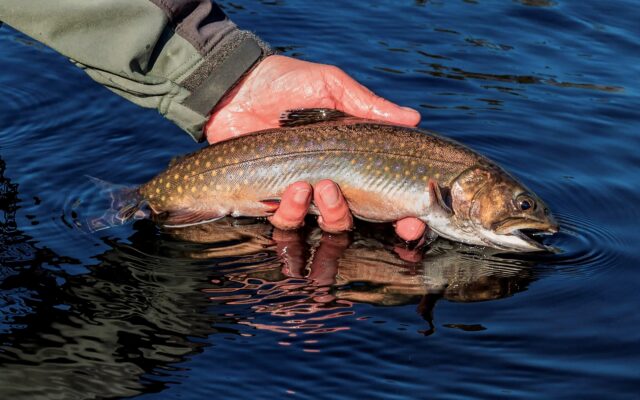
What is covered under Maine’s wanton waste of wildlife law
By Bob Mallard
I was recently approached by a fisheries manager in regard to supporting a proposal to put bag limits on non-game fish species.
The impetus of the proposal was to reduce the wanton waste of what many anglers refer to as “trash fish.â€
Sadly, many of these fish are native species that play an important role in regard to overall aquatic ecosystem health.
If you have spent any time fishing, or around water, you have likely seen dead fish lying about. In Maine, unfortunately, the victims of this wasteful practice are usually native fallfish and suckers, or other species of so-called rough fish.
Even game species such as trout don’t escape deliberate waste.
The former owner of a campground on the Kennebec River once told me that it was not uncommon to find discarded trout in the trash. He complained that it smelled, drew flies and attracted racoons and other wildlife.
Taxidermists have said that many gamefish left for mounting are never picked up.
With the increasing popularity of bowfishing, or hunting fish with a bow and arrow, thousands of slow-growing long-lived native buffalo, gar, bowfin, catfish and other fish are slaughtered and left to rot.
The problem was covered by conservation writer Matthew Miller in an article posted to The Nature Conservancy’s Cool Green Science blog in 2020.
Most states have a “wanton waste†law. The intention is to prohibit the deliberate waste of wildlife. Most require that the sportsman responsible for an animal’s demise make every possible attempt to retrieve it for consumption or use.
While the term “use†is ambiguous, it likely refers to fur-bearers and wildlife harvested for taxidermy.
Here is what Maine’s wanton waste law says:
§11224. Waste of game
1. Prohibition. A person may not waste a wild bird or wild animal that has been wounded or killed by that person while hunting. For purposes of this section, “waste” means to intentionally leave a wounded or killed animal in the field or forest without making a reasonable effort to retrieve and render it for consumption or use. This subsection does not apply to coyotes.
[PL 2009, c. 550, §3 (AMD).]
2. Penalty. A person who violates this section commits a Class E crime.
The title includes the term “game.†It’s fair to assume this means what are referred to as “game species.†But there is no definition on either the Maine Department of Inland Fisheries and Wildlife website or under Title 12 where most legal definitions involving fish and wildlife are housed.
There is a web page on the MDIF&W website under hunting called “Game Species,†albeit with no direct tie to the wanton waste law.
Per the department, while there is no definition for the term “game,†species covered under Maine’s wanton waste law are black bear, [white-tailed] deer, moose, turkey, ruffed grouse, bobwhite quail, pheasant, woodcock, common snipe, [legal to shoot] ducks, geese, sea ducks (scoter, eider, long-tailed duck), sora and Virginia rails (and gallinules [or rail]), crows, gray squirrel, red squirrel, snowshoe hare, bobcat, coyote, fox, raccoon, skunk, opossum, woodchuck, and porcupine, which ties exactly to the game species page noted above.
While coyotes are specifically exempted,crows, red squirrel, skunk, opossum and porcupine are not.
I’ve seen a lot of red squirrel shot, only a few of which were retrieved for use. Ditto for porcupines. I’ve encountered many carcasses in the woods over the years. And the crow hunters I’ve met don’t eat their kill. Are these people violating the law?
Another thing to note is the use of the term “hunting†in the text. There is no mention of fishing.
This implies that Maine’s wanton waste law is not only limited to game species, but it applies to birds and mammals only.
I reached out to MDIF&W for clarification as to whether fish were included and received a simple one word answer, “no.â€
It is important to note that other than brook trout, lake trout, landlocked salmon, whitefish and smelts; endangered Atlantic salmon and redfin pickerel; and threatened swamp darter, all other native freshwater fish are open to unrestricted harvest.
Maine’s wanton waste law includes the term “animal.†The common definition includes mammals, fish, birds, reptiles, amphibians and even insects.
The use of the term animal in conjunction with the word bird implies that whoever crafted the law meant mammal.
While game species have economic value due to hunting and fishing, all native species have ecological value, including non-game wildlife and fish.
If you want healthy ecosystems and game species, you need healthy nongame species populations.
If wanton waste is a threat to game species, it is a threat to all species, including nongame birds and mammals, and native fish, amphibians and reptiles. And waste is waste, regardless of the type of animal or its status.
Maine’s wanton waste law is incomplete. It’s also likely inconsistent with regard to its intent as it applies to hunted species that are not consumed or used.
It is time to rethink what we are trying to do here. That includes adding non-game species and fish with an exemption for nonnative species such as bass, pike and muskies. We should also define what “use†means.
There is far more to fish and wildlife management than game species. It is time we stopped treating fish and non-game wildlife as if they are somehow less important.